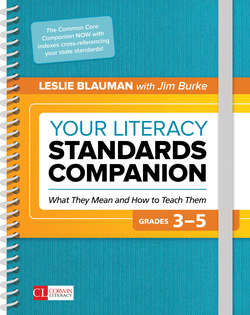Читать книгу Your Literacy Standards Companion, Grades 3-5 - Leslie Blauman - Страница 54
На сайте Литреса книга снята с продажи.
Common Core Reading Standard 4: Academic Vocabulary: Key Words and Phrases
ОглавлениеAllude to significant characters found in mythology: Allude means to make an indirect reference or to hint at. By alluding to characters found in mythology, the writer wants the reader to infer their key points. For example, Hercules was beyond the mortal man as far as strength. Therefore a Herculean task alludes to an enormous task—something beyond the ordinary—similarly, Achilles’ Heel alludes to a fatal weakness.
Connotative meanings: Words have primary or literal meaning; some also have a secondary or connotative meaning, which implies an additional idea or feeling related to the word or phrase.
Domain specific: Within each discipline or branch of that discipline, certain words (cell, division) have a domain-specific use in, for example, biology; other words, however, are unique to that discipline and are thus essential for students to know in order to read, discuss, and write about complex texts in that subject.
Figurative meanings: Figures of speech (or figurative language) are those often colorful ways we develop of saying something; they include euphemism, hyperbole, irony, understatement, metaphor, simile, personification, and paradox, among others. Some of them are specific to an era, region, or social group and thus can confuse readers.
General academic: In the CCSS, these are considered “tier 2” words—they are found in written texts and are vocabulary shared between teachers and students. These words lead to a “rich” vocabulary and are often words found in the thesaurus that students can substitute for common words. These words are more precise or subtle forms of familiar words and include multiple meaning words.
Interpret: This is best understood as a way a reader explains to himself—or another—his understanding of a piece or whole of a text; it’s the act of putting an author’s text into more accessible familiar language.
Literal from nonliteral language: Literal language is factual and explicit, the reader does not need to infer to glean the meaning. Nonliteral language implies figurative language—often similes, metaphors, personification, and also abstract words.
Metaphor: A figure of speech that does not use the words like or as to compare two unrelated objects. Rather, a metaphor states that the subject is the same as an unrelated object. For example, “the lake was a mirror”; although a lake cannot be glass or a mirror, this metaphor creates the visual that the lake was smooth and reflective in the same manner that a mirror is.
Simile: A figure of speech comparing two unlike things. Similes generally use like or as to create or link the comparison. For example “cute as a kitten” or “his eyes twinkled like stars.”
Technical meaning: In general this term relates to words with specialized meanings that are specific to a topic or subject being investigated. This can often be narrowed down to mean domain-specific words that typically occur in texts related to a specific content area such as rocks and minerals (igneous, metamorphic) or weather (cumulous, precipitation).
Tone: When thinking of tone, think tone of voice. The formal tone of the Constitution matches its importance and subject; the tone of a literary text may be formal or informal; the tone often reveals something about the dynamics between characters.
